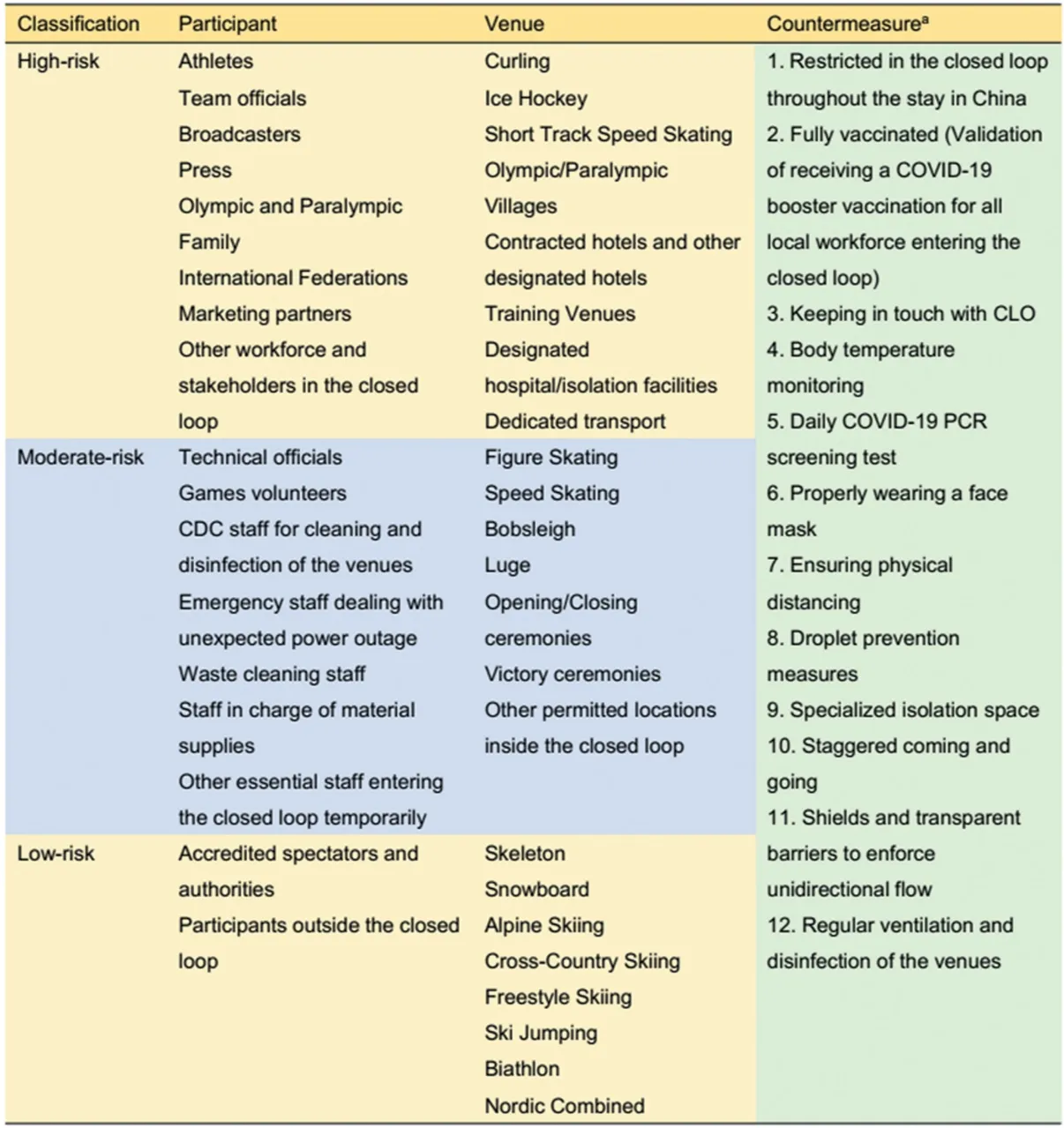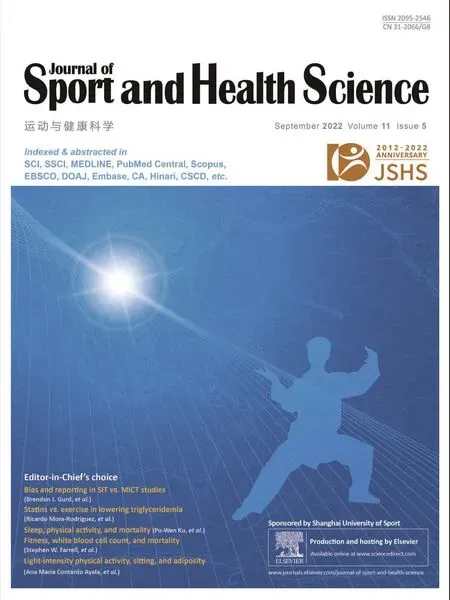Risk management strategies for the 2022 Olympic Winter Games:The Beijing scheme
Jie Liu,Jing Lou,Yong Wang,Jinjun Zhang,*
a Department of General Surgery,Beijing Tongren Hospital,Capital Medical University,Beijing 100730,China
b Emergence Medical Service Group for the Beijing 2022 Olympic Winter Games,Beijing Emergency Medical Center,Beijing 100031,China
c Games Services Department,Beijing Organizing Committee for the 2022 Olympic and Paralympic Winter Games,Beijing 102022,China
As the first international sporting event scheduled since the outbreak of the novel coronavirus disease 2019(COVID-19)pandemic,the Beijing XXIV Olympic Winter Games were officially held in China between the 4th and 20th of February 2022.1According to the International Olympic Committee(IOC),there were approximately 2900 elite athletes from 91 National Olympic Committees competing in 109 events during the 16 days of the Games.2In fact,under the conditions of a global pandemic,mass gatherings during large-scale sporting events represent a conducive environment for viral transmission given the close,prolonged,and frequent interactions between participants;this includes an increased risk of transmission of severe acute respiratory syndrome coronavirus 2(SARS-CoV-2).These conditions pose considerable public health challenges for the competition organizers and local governments.It was of paramount importance to develop detailed risk management measures and technical recommendations tailored to different events and scenarios to ensure the safety of all involved in the Olympic Games.
Even before the flame was lit at the Tokyo Olympic Stadium in 2021,the Tokyo Summer Olympic Games had been criticized for having taken insufficient and unscientific risk mitigation measures.3,4How to provide adequate safety measures was a dilemma for both the IOC and Beijing Organising Committee for the 2022 Olympic and Paralympic Winter Games.Winter is known to be a season of increased susceptibility to coronavirus infection.In addition,the global spread of the highly transmissible omicron virus variant had been confirmed,and local health authorities were confronted with unprecedented challenges with respect to minimizing the transmission of COVID-19 during the 2022 Olympic Winter Games.Despite these difficulties,the Beijing 2022 organizers made great efforts to establish scientifically based and practical countermeasures.According to the COVID-19 risk-mitigation guidelines from the World Health Organization,5recommendations from experts,and the latest practices from other large-scale events,2,6,7we had developed a system of classification for both the participants and the venues based on risk levels,and provided effective countermeasures.
1.Classification of participants
In consideration of the activities and locations,we classified the participants in the Games as belonging to high-risk,moderate-risk,and low-risk populations.First,the athletes,team officials,and the majority of stakeholders inside the“closed loop”were identified as belonging to the high-risk group;second,all members of the workforce in the closed loop,consisting of technical officials,Games volunteers,contractors,and other workforce members accredited by Beijing Organising Committee for the 2022 Olympic and Paralympic Winter Games,were regarded as belonging to the moderate-risk population;and finally,local designated spectators and authorities,in addition to local and foreign staff outside the“closed loop”,8were attributed to the relatively low-risk category(Fig.1).
2.Classification of venues
Preventive measures in terms of the sporting venues and key factors associated with the risk of SARS-CoV-2 transmission should involve at least the following considerations:the characteristics of the sporting events(individual or team sport);the duration and location(indoors vs.outdoors)of the competitions;stadium capacity and density of attendees;the possibility of designated seating;and the facilities available at the competition venues for mitigating measures(hand sanitizer,specialized isolation spaces,staggered coming and going,as well as shields and transparent barriers to enforce a unidirectional flow).Overall,all 15 categories of sports at the Beijing 2022 Olympics were classified as belonging to the relatively high-,moderate-,and low-risk categories with respect to COVID-19 considerations.Non-competition areas,such as the Olympic Villages,contracted hotels and other designated hotels,designated hospital/isolation facilities,dedicated transport,and opening/closing/victory ceremonies,were also categorized based on the risk of SARS-CoV-2 transmission(Fig.1).

Fig.1.The risk classification and countermeasures for the Beijing 2022 Olympic Winter Games.a Countermeasures are required for all Games participants and venues,especially the ones inside the closed loop.CDC=Centers for Disease Control and Prevention;CLO=COVID-19 Liaison Officer;COVID-19=coronavirus disease 2019;PCR=polymerase chain reaction.
3.Common countermeasures
Similar to the Tokyo 2020 Olympics9but stricter,the Beijing 2022 organizers proposed a series of risk mitigation principles and specific intervention protocols,8including requiring participants to be fully vaccinated at least 14 days prior to their departure for China;mandatory 21-day quarantine for those not fully vaccinated upon arrival in Beijing;employing COVID-19 Liaison Officers;rigorous but scientific COVID-19 polymerase chain reaction testing;tracing and isolation/quarantine criteria;minimizing physical interaction;and taking hygiene measures.
While it was reported by some experts and mass media that the infection control measures during the Tokyo 2020 Olympics were relatively successful,there was a surge of confirmed COVID-19 infections of Games-associated Japanese personnel and local residents.10Given that the range of activities was not limited to Games-associated personnel in the Tokyo 2020 Olympics,experts assumed that the virus may have been brought into the“bubble system”by Japanese support personnel.9,10
To cut off the possible transmission of SARS-CoV-2 from the local workforce involved in the Games,an innovative enclosed system called a“closed loop”was employed in the Beijing 2022 Olympic Winter Games.The closed loop was in place for all Games participants,with dedicated transport,accommodation,and specific venues for performing accredited activities agreed upon with Beijing Organising Committee for the 2022 Olympic and Paralympic Winter Games(Fig.2).Given full compliance with the protocols,separation between the Games participants and the general public outside of the closed loop was achieved.As such,the risk of transmission of SARS-CoV-2 between local residents and personnel involved in the Games was minimized.Detailed introductions were outlined in the Beijing 2022 Playbooks8(Fig.1).
According to the official figures reported by the IOC,11under stringent COVID-19 countermeasures,to date—of the 1,808,063 airport and screening tests conducted since the January 23,2022,when the closed-loop system officially came into effect—only 437 people tested positive.Meanwhile,there has not been any sign of SARS-CoV-2 spread from the closed loop to the local community.The closed-loop system was a great success and may have been one of the safest places on the planet during the Winter Games,according to IOC President,Thomas Bach.

Fig.2.Closed loop for the Beijing 2022 Olympic Winter Games.
PDuring the Games,the number one priority was the safety of all Olympic participants,athletes,Olympic personnel,and spectators.Beijing accomplished its“safe and successful”Winter Olympics promise.The risk mitigating scheme during the Beijing 2022 Olympic Winter Games should be meaningful for future organizers of major international sporting events.
Authors’contributions
JZ conceived the study idea for this article;JLiu wrote the first draft;JLou and YW suggested critical revisions.All authors were dedicated to the emergency medical services of the Beijing 2022 Olympic Winter Games.All authors have read and approved the final version of the manuscript,and agree with the order of presentation of the authors.
Competing interests
The authors declare that they have no competing interests.
 Journal of Sport and Health Science2022年5期
Journal of Sport and Health Science2022年5期
- Journal of Sport and Health Science的其它文章
- Risk of bias and reporting practices in studies comparing VO2max responses to sprint interval vs.continuous training:A systematic review and meta-analysis
- Effectiveness of statins vs.exercise on reducing postprandial hypertriglyceridemia in dyslipidemic population:A systematic review and network meta-analysis
- Association of accelerometer-derived step volume and intensity with hospitalizations and mortality in older adults:A prospective cohort study
- Number of parous events affects the association between physical exercise and glycemic control among women with gestational diabetes mellitus:A prospective cohort study
- Can physical activity eliminate the mortality risk associated with poor sleep?A 15-year follow-up of 341,248 MJ Cohort participants
- Cardiorespiratory fitness,white blood cell count,and mortality in men and women
